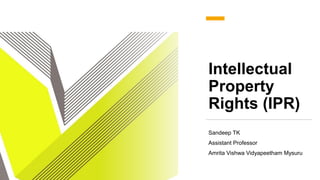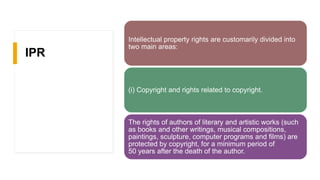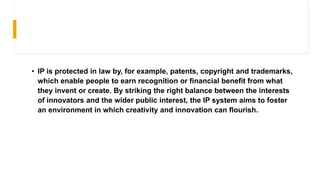IPR AD.pptx
- 1. Intellectual Property Rights (IPR) Sandeep TK Assistant Professor Amrita Vishwa Vidyapeetham Mysuru
- 2. Definition Intellectual property (IP) pertains to any original creation of the human intellect such as artistic, literary, technical, or scientific creation. Intellectual property rights (IPR) refers to the legal rights given to the inventor or creator to protect his invention or creation for a certain period of time. These legal rights confer an exclusive right to the inventor/creator or his assignee to fully utilize his invention/creation for a given period of time.
- 3. IPR Intellectual property rights are customarily divided into two main areas: (i) Copyright and rights related to copyright. The rights of authors of literary and artistic works (such as books and other writings, musical compositions, paintings, sculpture, computer programs and films) are protected by copyright, for a minimum period of 50 years after the death of the author.
- 4. âĒ IP is protected in law by, for example, patents, copyright and trademarks, which enable people to earn recognition or financial benefit from what they invent or create. By striking the right balance between the interests of innovators and the wider public interest, the IP system aims to foster an environment in which creativity and innovation can flourish.
- 5. Types of intellectual property âĒ Copyright âĒ Copyright (or authorâs right) is a legal term used to describe the rights that creators have over their literary and artistic works. Works covered by copyright range from books, music, paintings, sculpture, and films, to computer programs, databases, advertisements, maps, and technical drawings. This Photo by Unknown author is licensed under CC BY.
- 6. What can be protected? âĒ literary works such as novels, poems, plays, reference works, newspaper articles; âĒ computer programs, databases; âĒ films, musical compositions, and choreography; âĒ artistic works such as paintings, drawings, photographs, and sculpture; âĒ architecture; and âĒ advertisements, maps, and technical drawings.
- 7. âĒ Copyright protection extends only to expressions, and not to ideas, procedures, methods of operation or mathematical concepts as such. Copyright may or may not be available for a number of objects such as titles, slogans, or logos, depending on whether they contain sufficient authorship.
- 8. Patents âĒ A patent is an exclusive right granted for an invention, which is a product or a process that provides, in general, a new way of doing something, or offers a new technical solution to a problem. To get a patent, technical information about the invention must be disclosed to the public in a patent application.
- 9. âĒ In principle, the patent owner has the exclusive right to prevent or stop others from commercially exploiting the patented invention. In other words, patent protection means that the invention cannot be commercially made, used, distributed, imported or sold by others without the patent owner's consent.
- 10. âĒ Patents are territorial rights. In general, the exclusive rights are only applicable in the country or region in which a patent has been filed and granted, in accordance with the law of that country or region.
- 11. âĒ The protection is granted for a limited period, generally 20 years from the filing date of the application.
- 12. Trademarks âĒ A trademark is a sign capable of distinguishing the goods or services of one enterprise from those of other enterprises. Trademarks are protected by intellectual property rights.
- 13. âĒ A word or a combination of words, letters, and numerals can perfectly constitute a trademark. But trademarks may also consist of drawings, symbols, three-dimensional features such as the shape and packaging of goods, non-visible signs such as sounds or fragrances, or color shades used as distinguishing features â the possibilities are almost limitless.
- 14. âĒ a trademark registration will confer an exclusive right to the use of the registered trademark. This implies that the trademark can be exclusively used by its owner, or licensed to another party for use in return for payment. Registration provides legal certainty and reinforces the position of the right holder, for example, in case of litigation.
- 15. âĒ The term of trademark registration can vary but is usually ten years. It can be renewed indefinitely on payment of additional fees. Trademark rights are private rights and protection is enforced through court orders.
- 16. Industrial Designs âĒ In a legal sense, an industrial design constitutes the ornamental aspect of an article. âĒ An industrial design may consist of three-dimensional features, such as the shape of an article, or two- dimensional features, such as patterns, lines or colour.
- 17. âĒ the owner of a registered industrial design or of a design patent has the right to prevent third parties from making, selling, or importing rticles bearing or embodying a design which is a copy, or substantially a copy, of the protected design, when such acts are undertaken for commercial purposes.
- 18. âĒ Industrial designs are applied to a wide variety of products of industry and handicraft items: from packages and containers to furnishing and household goods, from lighting equipment to jewelry, and from electronic devices to textiles. Industrial designs may also be relevant to graphic symbols, graphical user interfaces (GUI), and logos.
- 20. Advantages of Intellectual Property Rights âĒ IPR protection gives your business a competitive advantage over other similar businesses. âĒ IPR protection allows you to prevent unauthorised use of your intellectual property and works. âĒ IPR enhances the value of your company and also opens avenues for collaborations and opportunities for generating income such as by entering into licensing agreements to exploit/work the invention/work. âĒ IPR helps to attract clients and creates your brand value. For example, the consumers start identifying your products with the unique logo or registered trademark.
- 21. Rights and Obligations of Patentee in India âĒ In India, the owner of an invention is required to get his/her invention patented under the Patent Act, 1970. the registration of a Patent provides certain Rights to the Patentee, which is mandatory to be followed by the Patentee
- 22. A Patent holder invents a procedure or product whose exclusive Rights and Obligations of Patentee are given to the Patent holder as an inspiring force for investment in creative or inventive exercises and for the spread of such exercises in public at large for learning.
- 23. There are a number of limitations and exceptions to these Rights and Obligations of Patentee which are as follows: âĒ Research or experimental utilization; âĒ usage on outdoor vessels; âĒ receiving administrative authorization from various professionals; âĒ reduction of Patent rights and similar imports; âĒ Compulsory relating and acquisition or use of inventions by the Governments.
- 24. The elaborated Rights of the Patentee in India are as follows
- 25. What are the Obligations of Patentee as per the Patent Act, 1970 Once a Patent is granted to a Patentee, there are certain Rights and Obligations of Patentee
- 26. âĒ The Patent Act, 1970, provides for provisions related to the Rights and Obligations of the Patentee of a Patent. The Controller of Patent is required to take care of all the Rights and Obligations of the Patentee as prescribed by the Patent Act, of 1970.
- 28. THANKS




























